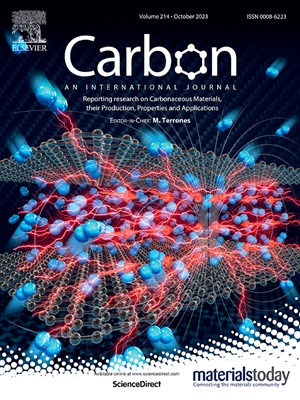Rice husk-based activated carbon/carbon nanotubes composites for synergistically enhancing the performance of lead-carbon batteries
IF 10.5
2区 材料科学
Q1 CHEMISTRY, PHYSICAL
引用次数: 0
Abstract
Lead-carbon batteries (LCBs), an advanced form of lead-acid battery (LAB) technology, incorporate super-capacitive carbon materials into the negative electrode. Rice husk-based activated carbon (RHAC) is a promising additive for LCBs due to its favorable properties. However, RHAC's amorphous structure impedes electronic conduction, and its zigzag microporous channels hinder ion transport, leading to degraded high-rate performance. This study addresses these issues by growing carbon nanotubes (CNTs) in situ on RHAC through a one-step heat treatment, resulting in carbon nanotubes-loaded RHAC (CNTs/RHAC), and the electronic conductivity and ionic conductivity are simultaneously enhanced. When CNTs constitute 30 wt% of CNTs/RHAC, the negative electrode achieves a cycle life of 4721 cycles at a 2C rate under 50 % state of charge, which is 10.04 times that of the blank anode. The enhanced performance is attributed to the synergistic effects of CNTs and RHAC, where CNTs form long-range conductive networks among the negative electrode active material (NAM) and facilitate the diffusion and electro-deposition of Pb2+, while the high specific surface area (SSA) and hierarchical porous structure of RHAC enhance its capacitive function, leading to a stable lead-carbon composite structure.

稻壳基活性炭/碳纳米管复合材料用于协同提高铅-碳电池的性能
铅碳电池(LCB)是铅酸蓄电池(LAB)技术的一种先进形式,它在负极中加入了超电容碳材料。稻壳基活性炭(RHAC)具有良好的特性,是一种很有前景的铅碳电池添加剂。然而,RHAC 的无定形结构阻碍了电子传导,其之字形微孔通道也阻碍了离子传输,从而导致高速率性能下降。为了解决这些问题,本研究通过一步热处理在 RHAC 上原位生长碳纳米管(CNTs),从而得到了负载碳纳米管的 RHAC(CNTs/RHAC),并同时提高了电子传导性和离子传导性。当碳纳米管在 CNTs/RHAC 中占 30 wt% 时,负极在 50 % 荷电状态下以 2C 速率循环寿命达到 4721 次,是空白负极的 10.04 倍。性能的提高归功于 CNTs 和 RHAC 的协同效应,其中 CNTs 在负极活性材料(NAM)中形成长程导电网络,促进了 Pb2+ 的扩散和电沉积,而 RHAC 的高比表面积(SSA)和分层多孔结构增强了其电容功能,从而形成了稳定的铅碳复合结构。
本文章由计算机程序翻译,如有差异,请以英文原文为准。
求助全文
约1分钟内获得全文
求助全文
来源期刊

Carbon
工程技术-材料科学:综合
CiteScore
20.80
自引率
7.30%
发文量
0
审稿时长
23 days
期刊介绍:
The journal Carbon is an international multidisciplinary forum for communicating scientific advances in the field of carbon materials. It reports new findings related to the formation, structure, properties, behaviors, and technological applications of carbons. Carbons are a broad class of ordered or disordered solid phases composed primarily of elemental carbon, including but not limited to carbon black, carbon fibers and filaments, carbon nanotubes, diamond and diamond-like carbon, fullerenes, glassy carbon, graphite, graphene, graphene-oxide, porous carbons, pyrolytic carbon, and other sp2 and non-sp2 hybridized carbon systems. Carbon is the companion title to the open access journal Carbon Trends. Relevant application areas for carbon materials include biology and medicine, catalysis, electronic, optoelectronic, spintronic, high-frequency, and photonic devices, energy storage and conversion systems, environmental applications and water treatment, smart materials and systems, and structural and thermal applications.
 求助内容:
求助内容: 应助结果提醒方式:
应助结果提醒方式:


